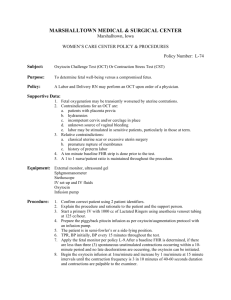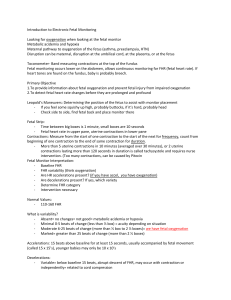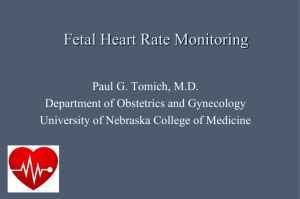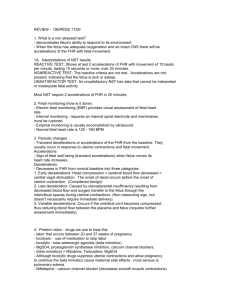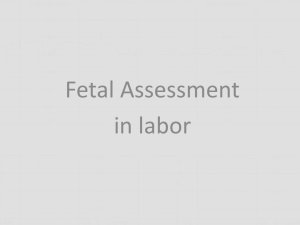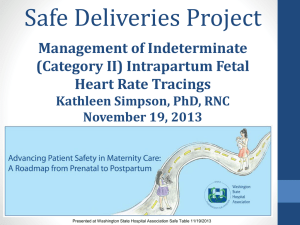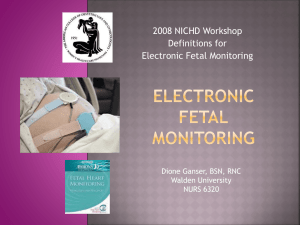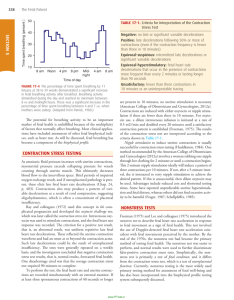Fetal Monitoring Review Questions
advertisement
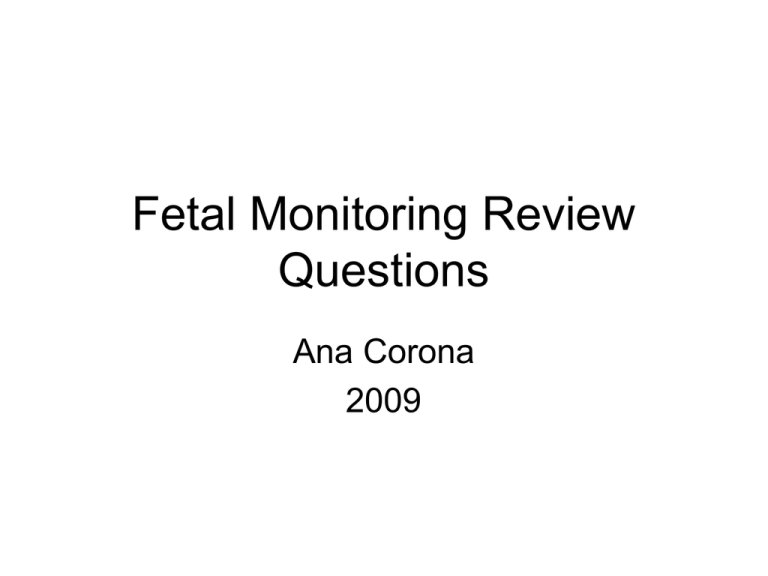
Fetal Monitoring Review Questions Ana Corona 2009 Variable decelerations in FHR during labor are severe dips occurring at the peak of contraction. This FHR problem is associated with which one of the following conditions? 1. 2. 3. 4. Utero-placental insufficiency Fetal head compression Uterine insufficiency Pressure on the umbilical cord Answer is 4 • These decelerations are common during labor. • The FHR drops during the contraction resulting from stimulation from chemoreceptors and baroreceptors as the cord is compressed. • The nurse should recognize these readings on the fetal monitor as normal. A nurse is caring for a client in labor and is monitoring the FHR patterns. The nurse notes the presence of episodic accelerations on the electronic fetal monitor tracing. Which of the following actions is most appropriate? 1. Document the findings and tell the mother that the monitor indicates fetal well-being 2. Take the mothers vital signs and tell the mother that bed rest is required to conserve oxygen. 3. Notify the physician of the findings. 4. Reposition the mother and check the monitor for changes in the fetal tracing Answer is 1 • Accelerations are transient increases in the fetal heart rate that often accompany contractions or are caused by fetal movement. • Episodic accelerations are thought to be a sign of fetal-well being and adequate oxygen reserve. A nurse is admitting a pregnant client to the labor room and attaches an external electronic fetal monitor to the client’s abdomen. After attachment of the monitor, the initial nursing assessment is which of the following? 1. Identifying the types of accelerations 2. Assessing the baseline fetal heart rate 3. Determining the frequency of the contractions 4. Determining the intensity of the contractions Answer is 2 • Assessing the baseline fetal heart rate is important so that abnormal variations of the baseline rate will be identified if they occur. • Options 1 and 3 are important to assess, but not as the first priority. A nurse is monitoring a client in labor. The nurse suspects umbilical cord compression if which of the following is noted on the external monitor tracing during a contraction? 1. 2. 3. 4. Early decelerations Variable decelerations Late decelerations Short-term variability Answer is 2 • Variable decelerations occur if the umbilical cord becomes compressed, thus reducing blood flow between the placenta and the fetus. • Early decelerations result from pressure on the fetal head during a contraction. • Late decelerations are an suggests uteroplacental insufficiency during a contraction. • Short-term variability refers to the beat-tobeat range in the fetal heart rate. The physician asks the nurse the frequency of a laboring client’s contractions. The nurse assesses the client’s contractions by timing from the beginning of one contraction: 1. 2. 3. 4. Until the time it is completely over To the end of a second contraction To the beginning of the next contraction Until the time that the uterus becomes very firm Answer is 3 • This is the way to determine the frequency of the contractions When monitoring the FHR of a client in labor, the nurse identifies an elevation of 15 beats above the baseline rate of 135 beats per minute lasting for 15 seconds. This should be documented as: 1. 2. 3. 4. An acceleration An early elevation A sonographic motion A tachycardic heart rate Answer is 1 • An acceleration is an abrupt elevation above the baseline of 15 beats per minute for 15 seconds; if the acceleration persists for more than 10 minutes it is considered a change in baseline rate. • A tachycardic FHR is above 160 beats per minute. Which of the following findings meets the criteria of a reassuring FHR pattern? 1. FHR does not change as a result of fetal activity 2. Average baseline rate ranges between 100 - 140 BPM 3. Mild late deceleration patterns occur with some contractions 4. Variability averages between 6 - 10 BPM Answer is 4 • Variability indicates a well oxygenated fetus with a functioning autonomic nervous system. • FHR should accelerate with fetal movement. • Baseline range for the FHR is 120 to 160 beats per minute. • Late deceleration patterns are never reassuring, though early and mild variable decelerations are expected, reassuring findings.
